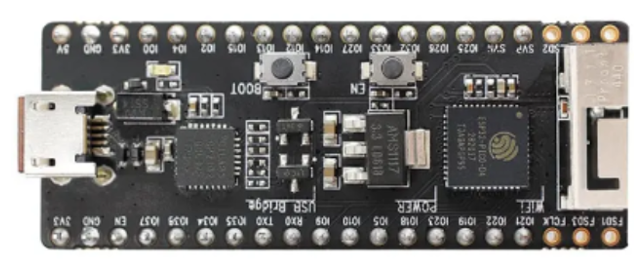The ESP32-Pico-D4 combines the functionality of an ESP32 chip with a 4 MB SPI flash memory. The ESP32 chip itself is a 32-bit microcontroller with dual cores, Wi-Fi, and Bluetooth support. The 4 MB flash memory provides maximum storage for program code and data. It is a system-in-package (SiP) module with more flash memory.
Features of ESP32-Pico-D4
The ESP32-Pico-D4 has many features that make it a versatile and powerful microcontroller:
- Dual-core 32-bit microcontroller
- Wi-Fi and Bluetooth support
- 4 MB SPI flash memory
- Low power consumption
- Wide range of peripherals
Main Highlights of ESP32-Pico-D4
The ESP32-Pico-D4 module offers the following key features:
Compact Size: With dimensions of approximately (7.000±0.100) mm × (7.000±0.100) mm × (0.940±0.100) mm, the module occupies minimal PCB space.
Integrated 4-MB SPI Flash: The module incorporates a 4-MB SPI flash for data storage and firmware.
Easy Integration: ESP32-PICO-D4 seamlessly integrates essential components. It contains on-board a crystal oscillator, flash memory, and filter capacitors.
No External Testing: Due to the inclusion of all necessary peripheral components, module testing is not required.
Suitable for Space-Limited and Battery-Operated Applications: ESP32-PICO-D4’s small size, reliable performance, and low-energy consumption make it an ideal choice for space-constrained and battery-powered applications like wearable electronics and other IoT products.
CPU and Internal Memory
The ESP32-Pico-D4 is shipped with onboard Xtensa 32-bit dual-core LX6 microprocessors:
- The ESP32-Pico-D4 has 448 KB of ROM. This ROM is used in booting the core functions of the board.
- The ESP32-Pico-D4 also has 520 KB of SRAM. This SRAM can be used to store data and instructions inside the board.
- The ESP32-Pico-D4 has an 8 KB SRAM. This memory is defined as RTC FAST Memory and is present in the RTC The main CPU can access this memory in deep sleep mode or during the Boot process of the board.
- The ESP32-Pico-D4 also has 8 KB SRA. This memory is defined as RTC Slow Memory. Most of the time RTC Slow memory is used by the co-processor in Deep-sleep mode.
- The ESP32-Pico-D4 board also has 1 Kbit of eFuse. Out of a total of 1 Kbits the 256 bits are assigned to the system’s purposes like MAC address and chip configuration. The remaining 768 bits of the module are dedicated to user applications, specifically for tasks such as managing memory usage, implementing flash encryption, and storing chip identification information.
External Flash and SRAM
The ESP32 microcontroller can support multiple external QSPI flash and SRAM chips. It also has a hardware encryption/decryption mechanism based on AES, which guarantees the security of programs and data stored in flash memory. The ESP32 allows access to external QSPI flash and SRAM using the high-speed caches.
Both the CPU instruction memory space and read-only memory space can utilize the external flash at the same time.
- When assigning the external flash to the CPU instruction memory space, a maximum of 11 MB + 248 KB can be allocated simultaneously. However, it’s crucial to keep in mind that if more than 3 MB + 248 KB are mapped, the CPU’s cache performance might be affected.
- When allocating the external flash to the read-only data memory space, it is possible to assign a maximum of 4 MB at a time. The system supports different data sizes, including 8-bit, 16-bit, and 32-bit.
Crystal Oscillators
The ESP32-PICO-D4 contains a 40 MHz crystal oscillator.
RTC and Power Consumption
The ESP32-Pico-D4 has support for advanced power-management systems. This board can change the power mode depending on the usage. It supports low-power mode, sleep mode, and ultra-low-power mode. Read details of ESP32’s different power modes in the following article:
ESP32 Sleep Modes & Their Power Consumption
Technical Specifications
| TYPE | DESCRIPTION |
| Product Status | Active |
| Digi-Key Programmable | Not Verified |
| RF Family/Standard | Bluetooth, WiFi |
| Protocol | 802.11b/g/n, Bluetooth v4.2 +EDR, Class 1, 2 and 3 |
| Modulation | CCK, DSSS, OFDM |
| Frequency | 2.4GHz ~ 2.5GHz |
| Data Rate | 150Mbps |
| Power – Output | 20.5dBm |
| Sensitivity | -98.4dBm |
| Serial Interfaces | GPIO, I²C, I²S, PWM, SDIO, SPI, UART |
| Antenna Type | – |
| Utilized IC / Part | ESP32 |
| Memory Size | 4MB Flash |
| Voltage – Supply | 2.7V ~ 3.6V |
| Current – Receiving | – |
| Current – Transmitting | – |
| Mounting Type | Surface Mount |
| Operating Temperature | -40°C ~ 85°C |
| Package / Case | 48-SMD Module |
| Operating current Average | 80 mA |
| Moisture sensitivity level (MSL) | Level 3 |
| Operating ambient temperature | –40 °C ~ 85 °C |
| Minimum current delivered by the power supply | 500 mA |
| Operating voltage/Power supply | 3.0 V ~ 3.6 V |
| Integrated crystal | 40 MHz crystal |
| On-chip sensor | Hall sensor |
How to Get Started with ESP32-Pico-D4
To upload code and generate output using ESP32-Pico-D4, the ESP-IDF framework is used. The ESP-IDF provides a comprehensive set of libraries, tools, and documentation for developing applications on the ESP32-Pico-D4.
Start by downloading and installing the ESP-IDF framework from the Espressif Systems website. The framework can be installed on different operating systems.
Conclusion
The ESP32-Pico-D4 is a compact design and low-power consumption board. The ESP32-PICO-D4 is a highly integrated system-on-chip (SoC) based on the ESP32 series from Espressif Systems. ESP32-Pico-D4 is designed and targeted for applications that require a compact form factor and low power consumption. One of the main highlights of ESP32-Pico is its 4MB flash memory size. For more info on ESP32-Pico read the article.

